
Download the PDF of this article
These are exciting times. In recent years there has been a surge of interest in woodworking in early years education. This can be clearly evidenced by the increasing sales figures from educational suppliers of workbenches and tools and increasing numbers of training sessions delivered. In some cases, this will be settings starting from scratch, in others, it’s a case of nurseries dusting down their workbench and digging out the tools after many years of neglect. The rise is not surprising since woodwork can provide a profound learning experience for children.
Woodwork has a long tradition within early years education. It has its origins in the pedagogy of Friedrich Froebel (1782-1852), while in the UK it was embraced by pioneering nursery schools in the late 19th century – there was even a monthly magazine, Hand and Eye(1882-1902), dedicated to promoting woodworking and other craft-work in kindergartens.
Today, teachers who provide woodwork regularly observe in young children exceptional levels of engagement, along with persistence and perseverance, especially in challenging tasks involving complex problem-solving. Woodwork is a truly cross-curricular activity, encompassing all areas of learning and development and can really play a central role in an early years curriculum.
Woodwork is exceptional for developing children’s creative and critical thinking skills as they tinker and experiment with the possibilities of wood and tools, then go on to express their ideas and resolve any challenges in executing those ideas. But woodwork is not about what children make; it is all about the benefits that it brings the child.
Woodwork can have a significant impact on children’s self-esteem and confidence and develop in them a sense of agency – that ‘can-do’ mindset. A number of schools are now using their pupil premium funding to buy woodwork equipment because of the way woodworking stimulates children’s curiosity and bolsters their confidence and willingness to learn.
In our increasingly digital world, it is important that children are still able to experience the joy of ‘making’ with real tools. The early years could be the only time in their whole education that they will work practically with tools, as most primary schools now avoid children working with resistant materials while less than half of secondary schools even offer design and technology as an option at GCSE.
This is clearly a disservice to children, as so many will go on to work with tools in a variety of ways later in life. Fortunately, the experience of working with tools leaves a lasting memory, so woodworking in early years can have a significant long-term impact. Woodwork also gives children the experience of making and repairing, so countering today’s prevailing culture of consuming and disposing.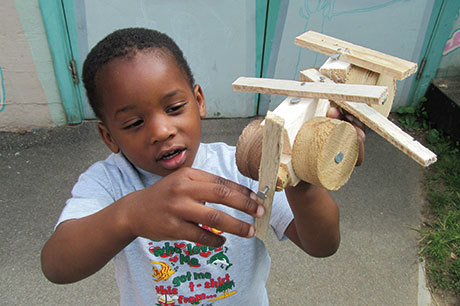
CHANGING ATTITUDES
Woodwork was nearly eradicated from early years education in the 1980s and 1990s due to risk aversion and over-zealous safety concerns, which were fuelled by the litigation culture of the time. Thankfully, current thinking about risk has become more balanced.
This turnaround started with Lord Young’s review of health and safety (Common Sense, Common Safety) in 2010, and since then the Health and Safety Executive, the Department for Education and Ofsted have all advocated a more appropriate attitude to risk. Now, it is generally believed that children need opportunities to experience risk so that they can learn to assess risk for themselves, rather than be over-protected and ‘wrapped in cotton wool’.
The extent to which attitudes were changing became evident in the DfE’s health and safety advice to schools, published in February 2014. It stated:
- Children should be able to experience a wide range of activities. Health and safety measures should help them to do this safely, not prevent them from engaging in the activities.
- It is important that children learn to understand and manage the risks that are a normal part of life.
- Common sense should be used in assessing and managing the risks of any activity. Health and safety procedures should always be proportionate to the activity’s risks.
- Staff should be given training so they can keep themselves and children safe and manage risks effectively.
These changing attitudes have encouraged an ever-increasing number of early years settings to establish woodwork areas. The learning benefits associated with woodwork are clear, but as educators our first and foremost commitment to young children must be ensuring their safety. It is true that the risks associated with woodwork are low if it is introduced and monitored properly, though, of course, there will still be the occasional banged thumb, splinter or cut.
In my 17 years of woodworking regularly with young children, two children have cut themselves with a saw – actually while handling it rather than sawing – but the cuts were small and superficial, and after a few tears and applying a plaster, the children were ready to go again. Far worse injuries happen regularly when children are running around in the playground. However, we should not be complacent.
LOW RISK
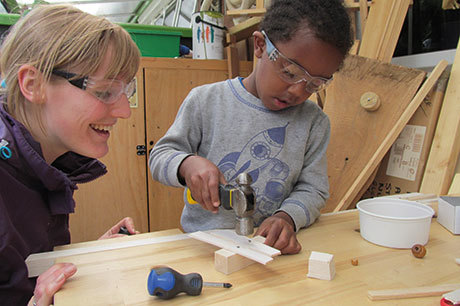
With the growing popularity of woodwork in early years settings, we need to ensure that it remains as low-risk an activity as it can be.
There are risks and, however small they are, there are measures we can put in place to minimise them and so keep woodwork as safe as possible. The last thing we need as a sector is for woodwork accidents to happen, as these may lead to knee-jerk reactions and a return to a risk-averse culture.
In the past year, however, the Early Years Woodwork Association (EYWA) has been made aware of some settings not adhering to best practice, so increasing the potential for harm to children – for example, not using eye protection or allowing very young children to use power drills.
Woodwork should always be a risk-assessed activity – some would advocate a risk/benefit assessment, though with all the benefits of woodwork, this would become a very lengthy document! Local authorities and Ofsted would expect settings to risk-assess woodwork and have health and safety measures in place.
With many practitioners themselves having little or no experience of working with tools, it can be a valuable investment to have some woodwork CPD training. This should focus on pedagogy but also allow practitioners the opportunity to experience and become competent using all the tools themselves. It is important to cover the basics, as many practitioners are unaware, for example, that wood must be clamped in a vice before sawing. Simple health and safety measures will also keep risks to a minimum (see boxes).
It is important that we maintain high-quality practice so that woodwork can remain a safe activity and a prominent feature within the early years curriculum, offering rich learning opportunities for all our children when they are enabled to follow their own interests. Establishing woodwork as part of a curriculum does take time and effort, but when you see the children’s enthusiasm, exceptional levels of engagement and pride in their work, it makes all the investment worthwhile.
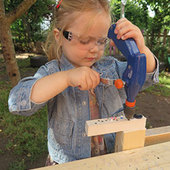 RESOURCES
RESOURCES
General tips
Invest in a sturdy workbench with a vice.
Let children work with (soft) balsa wood before moving to (harder) pine.
Use short, thin nails as they are easier to hammer in.
Glue a sheet of sandpaper to a board to make sanding easy.
Provide sliced-up corks as they make great wheels and are soft to hammer into.
Recommended tools
Good tools make the learning experience more satisfying and reduce the risk of accidents. The four main tools are:
Hammer The best type is a ‘stubby’ ball-pein hammer, which was designed for adults to hammer in awkward places and is now readily available. They are a perfect weight for young children to use, have short handles, making them easy to control, and have a large hitting surface. Children are more likely to miss thenail when using long pin-head hammers.
Saw Saws that cut on the pull stroke are easier for young children to control and require less effort than other types. I am a huge fan of Japanese pull saws, which are light, have thin blades and are extremely easy to use (with both hands).
Hand-drill Choose a drill with enclosed mechanisms to eliminate any chance of children’s fingers getting caught in exposed cogs. Short drill-bits are less likely to snap.
Screwdriver I recommend using a stubby Pozidriv screwdriver. Short-handled screwdrivers are easier to control and the Pozidriv ‘cross’ shape means the screwdriver is less likely to slip out from the screw.
Suppliers
Tools: www.cosydirect.com, www.muddyfaces.co.uk
Balsa wood: www.balsacabin.co.uk
Workbenches: www.communityplaythings.co.uk, www.cosydirect.com, www.creativecascade.co.uk, www.earlyexcellence.com
Full details: http://irresistible-learning.co.uk/resources
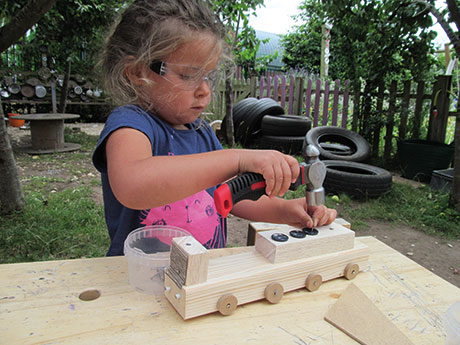
HEALTH AND SAFETY GUIDELINES: KEY MESSAGES
Children must wear safety glasses
There is a very small chance that a nail may rebound, or an item such as a button could shatter and impact the eye. Small safety glasses are readily available and more comfortable than goggles. It is important too that children learn to take responsibility for protecting themselves.
Teach all children how to use all tools
Draw children’s attention to sharp edges and points on tools. Keep a checklist of who has learnt to use which tool to ensure all children get the correct instruction. Remind children woodwork equipment should remain in the woodwork area. Introduce tools in small groups of 1:3.
Teach children how to hammer in nails
Hammering nails into harder wood such as pine requires considerably more force than into soft woods. Show children how to hold the nail between their finger and thumb and to tap the nail gently until it is standing in the wood. To drive the nail deeper they, importantly, need to hold the hammer well away from the nail before hammering hard.
Pick up nails and screws from the floor
A large magnet can work a treat for this – and there will be no shortage of volunteers!
Take care when using saws
Employ a 1:1 ratio so you can monitor the workbench and ensure no child is passing by or watching in front of the saw.
Children should hold a pull saw with both hands and a European cross-cut sawwith one handwhile holding the bench with the other – making sure it is positioned well away from the saw.
Children should always clamp wood in a vice before sawing it, and practitioners should always check that the wood is clamped tight.
After use, place the sawimmediatelyout of reach (but not out of sight) of the children.
Check wood for splinters
Avoid wood with lots of splinters, or sand it before using it. Remember a splinter in your finger can cause blood poisoning. First-aid guidance varies so check local guidelines. However, common sense suggests that if a splinter is protruding from a child’s finger, then remove it. Always inform parents about any splinters so they can monitor the area of skin for possible infection.
Example risk assessment forms and Health and Safety checklist: http://irresistible-learning.co.uk/resources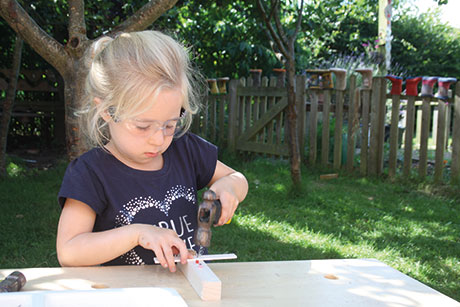
LEARNING THROUGH WOODWORK
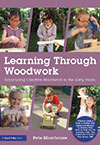 Learning Through Woodwork: Introducing Creative Woodwork in the Early Years by Pete Moorhouse (David Fulton, pb £19.99, e-book £17.99) is a comprehensive guide to introducing and supporting woodwork in an early years setting. Inspiring and informative, it outlines the many learning opportunities that woodwork provides children and offers clear and practical advice on resources, the adult role and health and safety.
Learning Through Woodwork: Introducing Creative Woodwork in the Early Years by Pete Moorhouse (David Fulton, pb £19.99, e-book £17.99) is a comprehensive guide to introducing and supporting woodwork in an early years setting. Inspiring and informative, it outlines the many learning opportunities that woodwork provides children and offers clear and practical advice on resources, the adult role and health and safety.
The author also draws on his 25-plus years’ working as an artist educator in early years settings to provide a treasure trove of ideas to encourage independent creative learning.
Professor Tina Bruce says, ‘Every so often a book is written that helps practitioners to develop their work in deep and far-reaching ways. This is that sort of book.’
To order a copy, visit: https://bit.ly/2DOHjqX
MORE INFORMATION
Pete Moorhouse, studio@petemoorhouse.co.uk
CPD information is at: http://irresistible-learning.co.uk, www.stwerburghs.com and www.early-education.org.uk









